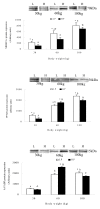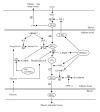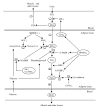Impact of dietary protein on lipid metabolism-related gene expression in porcine adipose tissue
- PMID: 20205889
- PMCID: PMC2827416
- DOI: 10.1186/1743-7075-7-6
Impact of dietary protein on lipid metabolism-related gene expression in porcine adipose tissue
Abstract
Background: High dietary protein can reduce fat deposition in animal subcutaneous adipose tissue, but little is known about the mechanism.
Methods: Sixty Wujin pigs of about 15 kg weight were fed either high protein (HP: 18%) or low protein (LP: 14%) diets, and slaughtered at body weights of 30, 60 or 100 kg. Bloods were collected to measure serum parameters. Subcutaneous adipose tissues were sampled for determination of adipocyte size, protein content, lipid metabolism-related gene expression, and enzyme activities.
Results: HP significantly reduced adipocyte size, fat meat percentage and backfat thickness, but significantly increased daily gain, lean meat percentage and loin eye area at 60 and 100 kg. Serum free fatty acid and triglyceride concentrations in the HP group were significantly higher than in the LP group. Serum glucose and insulin concentrations were not significantly affected by dietary protein at any body weight. HP significantly reduced gene expression of acetyl CoA carboxylase (ACC), fatty acid synthase (FAS) and sterol regulatory element binding protein 1c (SREBP-1c) at 60 kg and 100 kg; however, the mRNA level and enzyme activity of FAS were increased at 30 kg. HP promoted gene and protein expression and enzyme activities of lipoprotein lipase (LPL), carmitine palmtoyltransferase-1B (CPT-1B), peroxisome proliferator-activated receptor gamma (PPARgamma) and adipocyte-fatty acid binding proteins (A-FABP) at 60 kg, but reduced their expression at 100 kg.Gene expression and enzyme activity of hormone sensitive lipase (HSL) was reduced markedly at 60 kg but increased at 100 kg by the high dietary protein. Levels of mRNA, enzyme activities and protein expression of ACC, FAS, SREBP-1c and PPARgamma in both LP and HP groups increased with increasing body weight. However, gene and protein expression levels/enzyme activities of LPL, CPT-1B, A-FABP and HSL in both groups were higher at 60 kg than at 30 and 100 kg.
Conclusion: Fat deposition in Wujin pigs fed high dietary protein for 25 weeks was reduced mainly by depression of lipogenic gene expression. The mechanism of lipid transport, lipolysis and oxidation in adipose tissue regulated by dietary protein appeared to be different at 60 kg and 100 kg body weights.
Figures






References
-
- Allee GL, Romsos D, Leveille GA, Baker DH. Influence of age on in vitro lipid biosynthesis and enzymatic activity in pig adipose tissue. Proc Soc Exp Biol Med. 1971;137:449–452.
-
- O'Hea EK, Leveille GA. Significance of adipose tissue and liver as sites of fatty acid synthesis in the pig and the efficiency of utilization of various substrates for lipogenesis. J Nutr. 1969;99:338–344. - PubMed
-
- Hirsch J, Han PW. Cellularity of rat adipose tissue: effects of growth, starvation, and obesity. J Lipid Res. 1969;10:77–82. - PubMed
LinkOut - more resources
Full Text Sources
Research Materials
Miscellaneous

